COL. BACON KISSED THE WIVES (1905)

It is a shame the way newspaper reporters don’t write these days. The folksy, tongue-in-cheek, gossipy style of 100 years ago would today seem too daring, too familiar. And perhaps newspapers now are just a little too gun-shy of potential libel suits… Here is a story reported by the Brooklyn Daily Eagle in 1905, that combines all the elements of a ribald over-the-fence tittle-tattle: Brooklyn Daily Eagle, Fri., 20 October 1905 — The home makers and home defenders of Prospect Park South were stirred this morning to dark purposes. Quite well it was that Colonel Alexander S. Bacon got away from Ditmas Park home in that aristocratic section before his neighbors saw the morning papers in which the gallant colonel was depicted in the very act of kissing their wives. Not only that, but the same papers had Colonel Bacon declaring publicly that he had been enjoying sweet osculatory favors. It all grew out of Colonel Bacon’s law business. He was defending Mrs. Hortense Powers from the suit of her husband, William F. Powers, who wanted a divorce on the ground that Mrs. Powers had been too free with her kisses and favors for a neighbor, “Billy” Campbell. Colonel Bacon tried to excuse and justify these little tokens of affection. Here is the argument he was reported to have used before the jury: “Gentlemen, every one of you who is married probably has kissed his neighbor’s wife. Without wishing to be egotistical, I might say that I have been fortunate […]
THE STOOL PIGEON & THE HOLDUP (1931)
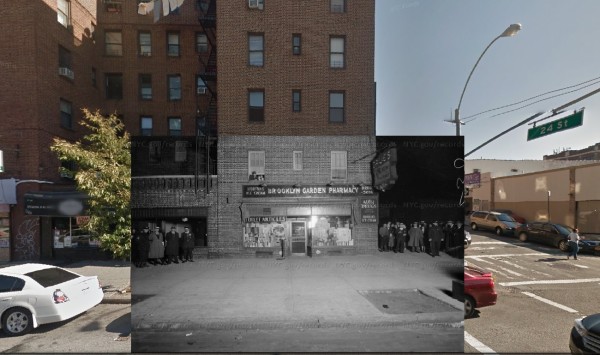
(The New York Police Department has several thousand photographs of crime scenes available online at the City’s Department of Records. Many of them are gruesome. But they are great pictures for doing research. The picture in this blog post was taken after a holdup at 729 4th Avenue in 1931. Although the pictures usually have limited or poor information associated with the photos, after a bit of some rudimentary research, we can usually find the whole story in old newspaper archives. Finding these, we are able to piece together the story behind the photograph.) THE STOOL PIGEON & THE BODYGUARD The picture above (the black & white inset photograph) is the scene of a holdup, which took place at 729 4th Avenue, Brooklyn, on 16 May 1931. Two men were shot during the event, but before it took place, another – providential – event occurred, which stymied the holdup and caused the arrests of the three men. Chile Acuna, whose revelations pried off the lid of police vice squad conditions (read about it here) was arriving home at 740 4th Avenue around 11:30 p.m. on 16 May 1931. His wife and their two kids were with them. So was their bodyguard, Patrolman William F. O’Brien. THE HOLDUP Noticing the vehicle at the curb of the drugstore across the street, O’Brien observed what happened next. He saw three men exit the vehicle while the fourth remained at the wheel. As the three men approached the drugstore, O’Brien told Acuna: “Run upstairs […]
TIMEWARP TUESDAY! DEAN ST. (1905 v. 2014)
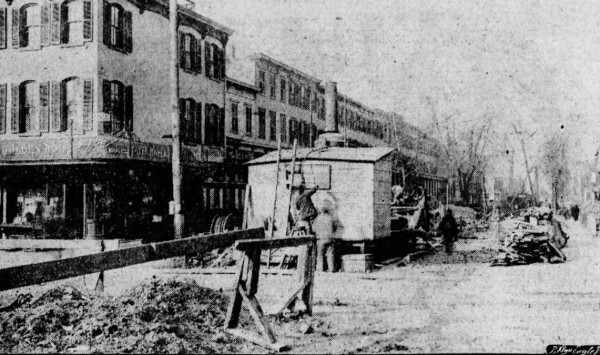
******************************************************************************************************************************** Brownstone Detectives investigates the history of our clients’ homes. The story you are about to read was composed from research conducted in the course of one of those investigations. Do you know the history of YOUR house? ******************************************************************************************************************************** Back in late 1904/early 1905, people living on Dean Street, from Third to Fifth avenues, and on Fifth Avenue, from Dean Street to Flatbush Avenue, were “complaining bitterly of the condition of the streets, which have been torn up for a number of months. “The sidewalks are covered with dirt and rubbish and traffic is delayed seriously.” Pictured is the intersection at Dean Street and 4th Avenue – in 1905 and in 2014. Can you spot the differences between the two pictures? Follow @BrownstoneDetec Share ———————————————————————————————————————– The Brownstone Detectives Brownstone Detectives is an historic property research agency. Our mission is to document and save the histories of our clients’ homes. From our research, we produce our celebrated House History Books and House History Reports. Contact us today to begin discovering the history of your home.
ATLANTIC TERMINAL – 1910 vs. 2018
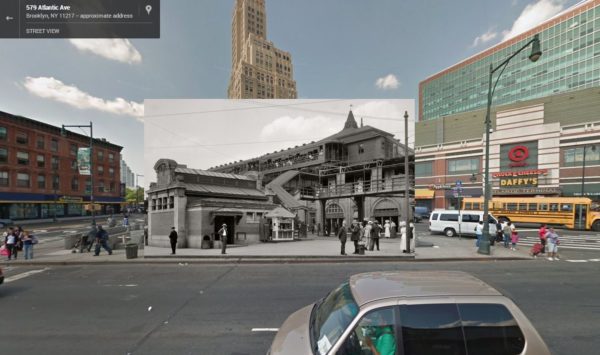
******************************************************************************************************************************** Brownstone Detectives investigates the history of our clients’ homes. The story you are about to read was composed from research conducted in the course of one of those investigations. Do you know the history of YOUR house? ******************************************************************************************************************************** We found a photograph taken at the “Atlantic Avenue subway entrance,” circa. 1910, and superimposed it onto an image taken from the same location, circa. today (courtesy Google Maps). The old picture shows an elevated railway and streetcar tracks in the background – the elevated railway is now underground and the streetcar has been replaced by city busses. If you look closely at the train cars, you can see that they are open on the sides, showing the time of year the photograph was taken. Also telling of the period (and the time of the year) are the boaters that the men are wearing – they were en vogue in mean’s spring/summer fashion at the time. There are also a couple of policemen, looking very much like London “bobbies” or “Keystone Cops” with their distinctive helmets. Notice anything else? Follow @BrownstoneDetec Share ———————————————————————————————————————– The Brownstone Detectives Brownstone Detectives is an historic property research agency. Our mission is to document and save the histories of our clients’ homes. From our research, we produce our celebrated House History Books and House History Reports. Contact us today to begin discovering the history of your home.
A TREE FALLS ON PROSPECT PLACE (1901)
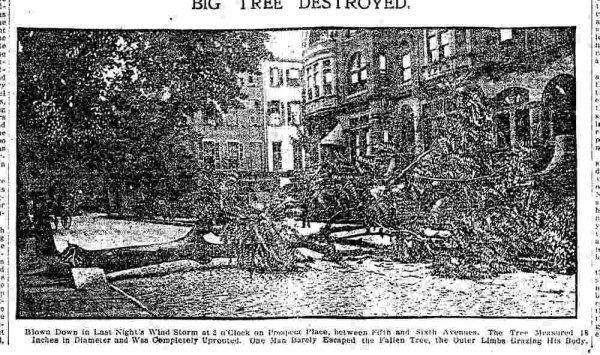
******************************************************************************************************************************** Brownstone Detectives investigates the history of our clients’ homes. The story you are about to read was composed from research conducted in the course of one of those investigations. Do you know the history of YOUR house? ******************************************************************************************************************************** On the night of July 11, 1901, Brooklyn experienced a “Wind Storm” that knocked down a number of trees. One of those fallen trees crossed Prospect Place between 5th and 6th Avenues. One man “barely escaped the fallen tree, with the outer limbs grazing his body.” The storm must not have done much damage, though, as this picture – in the Brooklyn Daily Eagle – was the only reference to it. Just a little over a week earlier, though, trees were falling faster than Brooklyn home prices in 2009, when a wind storm killed two men at Coney Island and caused extensive damage at Parkville (a suburb then just west of Kensington). “Great trees, four and five feet in circumference, were uprooted and hurled across fences and into yards where gardens were the pride of the household,” noted the Eagle. “When the strong winds swept across the open fields between Coney Island avenue and the Ocean Parkway between Franklin avenue and Avenue D,” the Eagle continued, “it carried away with it four frame cottages being erected by the Morris Construction Company.” When the skies had finally cleared, the locals would view the distruction – the suburb was “full of wreckage. Every street was full of fallen trees…” Follow @BrownstoneDetec Share ———————————————————————————————————————– […]
SUBWAY DIGGING – GRAND ARMY PLAZA (1914)
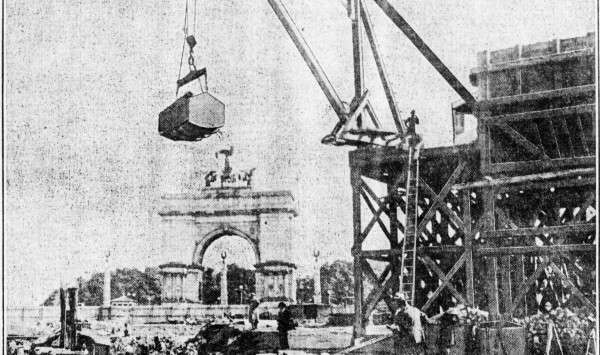
“Dirt is beginning to fly with telling effect in the excavations for the extension of the subway through Flatbush Avenue and out Eastern parkway,” noted the Brooklyn Daily Eagle in their 30 August 1914 edition. “The Above picture shows the big steam shovel at work close to the sailors and soldiers Monument at the Plaza of Prospect Park. Which is seen in the background. This excavation of the present subway will be constructed faster than the Fourth Avenue line has been because there are neither troubles about obtaining title to abutting lands nor the physical difficulties which reset the Fulton Street section of the Fourth Avenue line.” Follow @BrownstoneDetec ———————————————————————————————————————– The Brownstone Detectives The story you have just read was composed from extensive historical research conducted by The Brownstone Detectives. Our clients commission us to investigate the history of their – or their clients’ – historic properties. From our findings, we produce their very own hardbound House History Books. Our books are professionally written and laid out, containing illustrated and colorful narratives that bring the history of any house to life. Contact us today to begin discovering the history of your home.
The Reincarnation of Teddy Roosevelt (1912)

******************************************************************************************************************************** Brownstone Detectives investigates the history of our clients’ homes. The story you are about to read was composed from research conducted in the course of one of those investigations. Do you know the history of YOUR house? ******************************************************************************************************************************** 1 April 1912 – Brooklyn, N.Y. – A well-dressed man appeared in Brooklyn Police Headquarters two hours before sunrise on the 1st of April and, after introducing himself as the reincarnation of Theodore Roosevelt, “promptly dismissed all the lieutenants, detectives and policemen in the structure from the Police Department. “What appeared to be a merry jest on the part of the stranger was enjoyed until he attempted by rather progressive and aggressive tactics to yank some of the lieutenants out of the chairs and hurl them into the street in order to show his word must be obeyed,” The Evening Telegram of 1 April 1912 observed. “It then dawned on the smiling lieutenants, detectives and policemen that the reincarnation of the Rough Rider was not in any sense an April Fool joker.” “Teddy” – or Joseph Condon, of No. 142 Atlantic Avenue – was evidently very much under the impression, though, that he was – if not Theodore Roosevelt, himself – the reincarnation of same. “Roosevelt” thereupon imposed a three months’ fine on Policeman Franklin and then assigned him to Tottenville, Staten Island. When Franklin asked “Teddy” to show him the way there, Condon said he would not go until the dismissed lieutenants, detectives and policemen had left the building. After […]
THE BOY WHO COULDN’T MEND (1914)
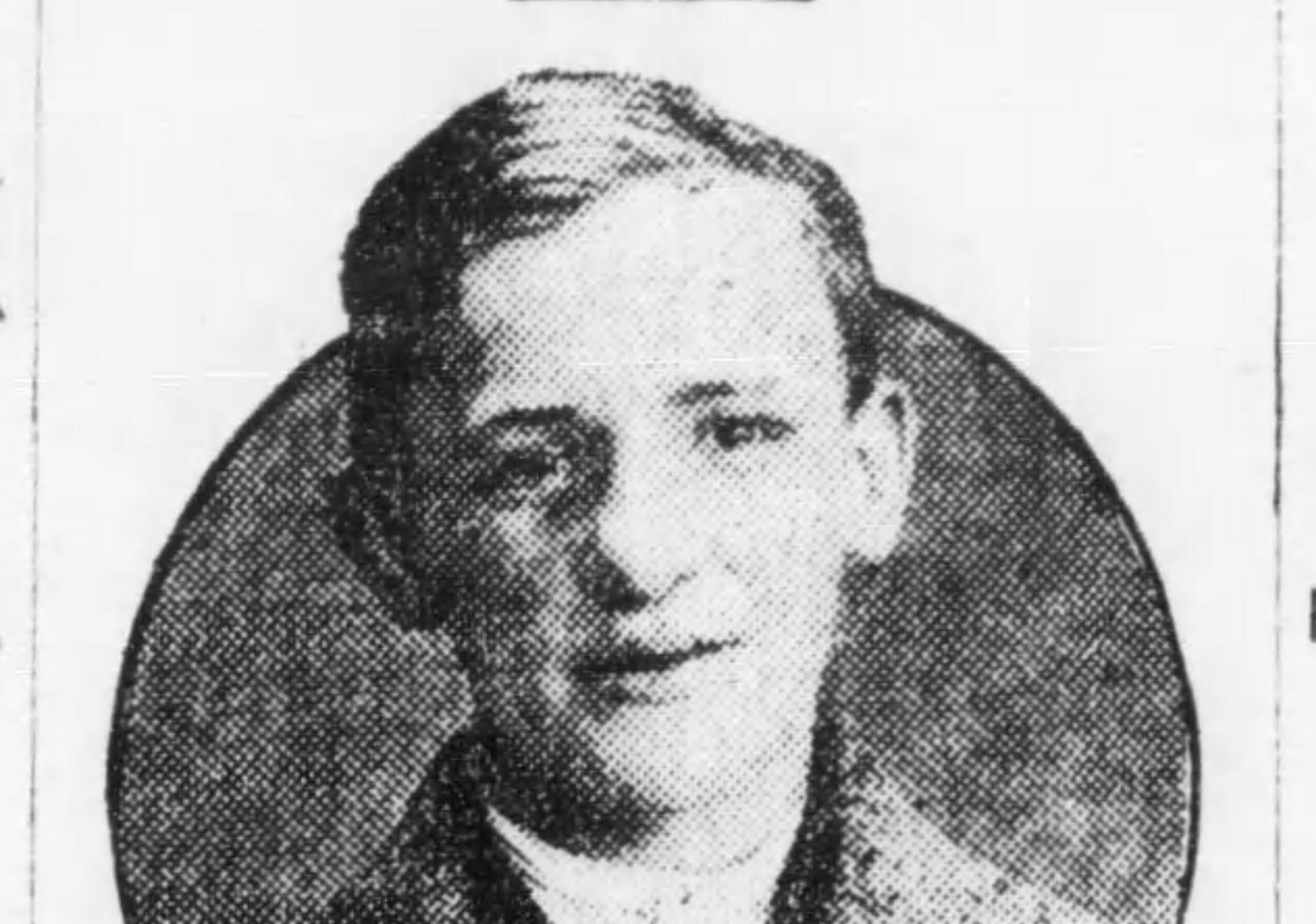
Some criminals just cannot reform. Young Raymond “Angel Face” Beck was a good example. 100 years ago today, the 14-year-old Brooklyn boy was pawning stolen silverware on Atlantic Avenue when the police happened into the pawn shop. NO JUVENILE ASYLUM BUILT COULD HOLD THE “ROBBER CHIEF” Known mostly for his escapes from “prison,” at the time, Raymond Beck, “son of well-to-do parents of 7 Cypress Avenue,” and a self-described “Robber Chief,” had broken out of the Dobbs Ferry Juvenile Asylum a total of four times by 1914. Each time young Beck, “blue-eyed, fair-haired and innocent-looking,” made a B-line directly for Brooklyn and the houses of new victims. Beck would make a career of illegal activity and escaping asylums and reform schools throughout his life. The newspapers are replete with his stories of burglaries and escapes at least through the mid-1920s, when he would finally disappear from the news. But, for the majority of this period, whenever the name Raymond Beck was mentioned in the papers, Brooklynites locked their doors and hid their valuables, as there was a good chance they’d end up in his possession. “ANGEL FACE” RETURNS TO BROOKYLN After the “boy burglar” had most recently been paroled in 1914, he ended up in Brooklyn once again – this time in the parlor of Edward A. Peterson of 567 Eighth Street in Park Slope. Now, Peterson did not know “Angel Face,” but that was not only because the two had never been introduced. Beck simply arrived at Peterson’s home […]
THE SECOND HUMILIATION OF WARREN (1960)
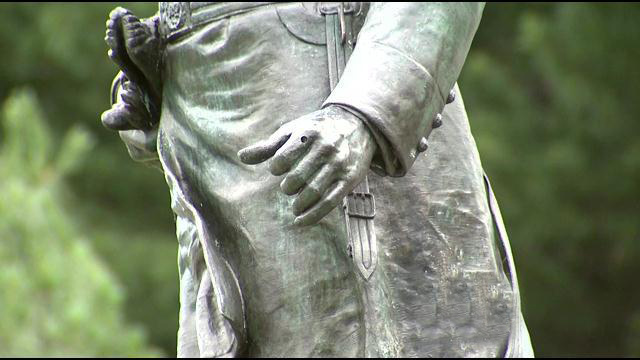
A number of New York City Parks Department statues are having their stolen swords replaced reported a DNAInfo story. The statues, most of which have had their their swords stolen (bayonets, and glasses, in some instances) during times of high crime, are now deemed worthy of replicas being cast. The Parks Department worries less now about the replicas being stolen themselves. I’ve often noticed one such statue in particular – the Kemble Warren statue at the Grand Army Plaza. First of all, why was it there? What had Warren, an engineer, done that could have been so critical to the war effort? Had he been a critical part of the attack at any actual battle? I figured that, as an engineer, he had – more likely – prepared a defense. But was that enough to receive a statue? KEMBLE WARREN – A HUMILIATION Gouverneur Kemble Warren, the engineer for whom the statue at the Grand Army Plaza had been cast and dedicated, had been known for his heroism at Gettysburg. By the time that General Philip Sheridan had begun his “burning of the Shenandoah Valley,” though, Warren had been castigated by, what Sheridan referred to as, a critical slowness in arriving to a certain battle. Because of this, Warren had been relived of duty by the general (an action supported by General Grant, at the time) and assigned to another, less critical, theater of battle. The humiliation of the relief of command, though, had already had its effect. After some […]
SO A TAXICAB JUMPS INTO A FOUNTAIN… (1909)
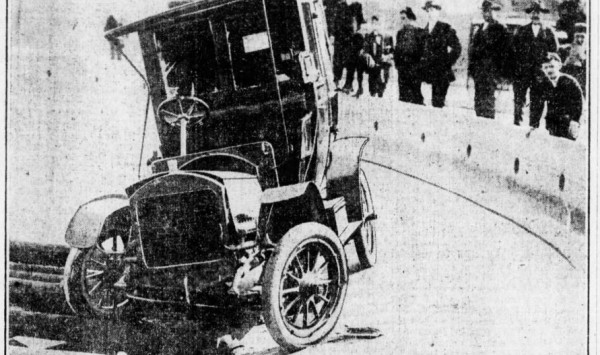
******************************************************************************************************************************** Brownstone Detectives investigates the history of our clients’ homes. The story you are about to read was composed from research conducted in the course of one of those investigations. Do you know the history of YOUR house? ******************************************************************************************************************************** When Brooklyn woke up one April morning in 1909, there in Prospect Park Plaza’s “Electric Fountain” sat a little blue taxicab. To many, the thing appeared as though it had always belonged there. Some wondered whether they’d simply not noticed it all along. But others realized that something was wrong. Something was certainly wrong. THE CASE OF THE IMPETUOUS TAXICAB It seems as though the Grand Army Plaza has always had a fountain. But back when the plaza was called Prospect Park Plaza and it encompassed a larger amount of land, that fountain was much larger and took up much more space. The fountain was then what was called an “electric fountain,” and after it was installed it would attract people by the thousands each year when the lights and the water were turned on. One year, after the winter had passed and after the water was supposed to have filled the reservoir, with the jets darting, and the lights dancing, the fountain sat silent. So, as popular as the fountain was to Brooklyn, the reporters of the city had descended upon Parks Commissioner Kennedy about it’s inactivity. And in the midst of the hubbub – came the crash. HOW IT ALL CAME ABOUT It was 11:30 on a Sunday night […]